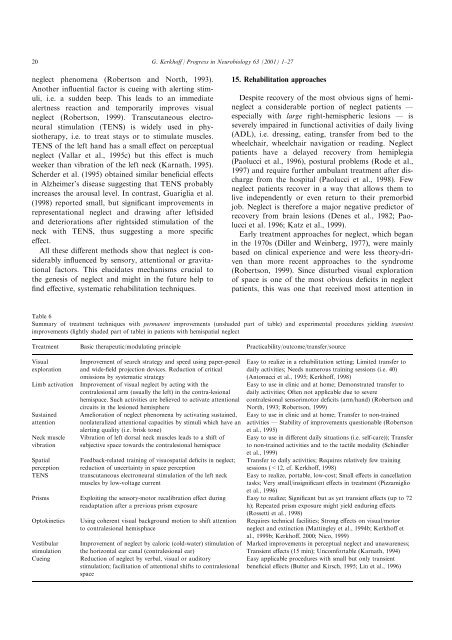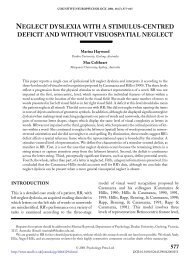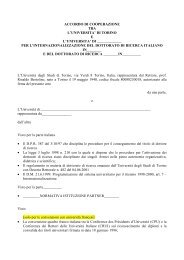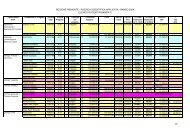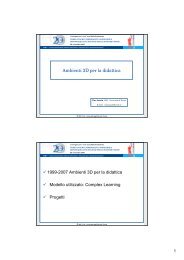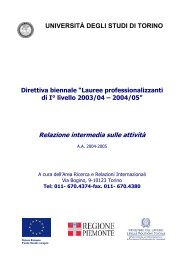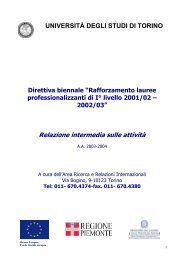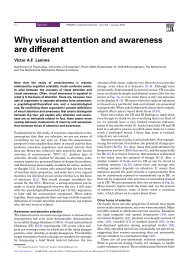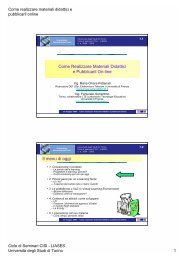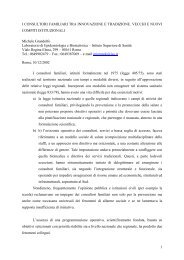Spatial hemineglect in humans - Cisi
Spatial hemineglect in humans - Cisi
Spatial hemineglect in humans - Cisi
You also want an ePaper? Increase the reach of your titles
YUMPU automatically turns print PDFs into web optimized ePapers that Google loves.
20<br />
G. Kerkho€ / Progress <strong>in</strong> Neurobiology 63 (2001) 1±27<br />
neglect phenomena (Robertson and North, 1993).<br />
Another <strong>in</strong>¯uential factor is cue<strong>in</strong>g with alert<strong>in</strong>g stimuli,<br />
i.e. a sudden beep. This leads to an immediate<br />
alertness reaction and temporarily improves visual<br />
neglect (Robertson, 1999). Transcutaneous electroneural<br />
stimulation (TENS) is widely used <strong>in</strong> physiotherapy,<br />
i.e. to treat stays or to stimulate muscles.<br />
TENS of the left hand has a small e€ect on perceptual<br />
neglect (Vallar et al., 1995c) but this e€ect is much<br />
weeker than vibration of the left neck (Karnath, 1995).<br />
Scherder et al. (1995) obta<strong>in</strong>ed similar bene®cial e€ects<br />
<strong>in</strong> Alzheimer's disease suggest<strong>in</strong>g that TENS probably<br />
<strong>in</strong>creases the arousal level. In contrast, Guariglia et al.<br />
(1998) reported small, but signi®cant improvements <strong>in</strong><br />
representational neglect and draw<strong>in</strong>g after leftsided<br />
and deteriorations after rightsided stimulation of the<br />
neck with TENS, thus suggest<strong>in</strong>g a more speci®c<br />
e€ect.<br />
All these di€erent methods show that neglect is considerably<br />
<strong>in</strong>¯uenced by sensory, attentional or gravitational<br />
factors. This elucidates mechanisms crucial to<br />
the genesis of neglect and might <strong>in</strong> the future help to<br />
®nd e€ective, systematic rehabilitation techniques.<br />
15. Rehabilitation approaches<br />
Despite recovery of the most obvious signs of <strong>hem<strong>in</strong>eglect</strong><br />
a considerable portion of neglect patients Ð<br />
especially with large right-hemispheric lesions Ð is<br />
severely impaired <strong>in</strong> functional activities of daily liv<strong>in</strong>g<br />
(ADL), i.e. dress<strong>in</strong>g, eat<strong>in</strong>g, transfer from bed to the<br />
wheelchair, wheelchair navigation or read<strong>in</strong>g. Neglect<br />
patients have a delayed recovery from hemiplegia<br />
(Paolucci et al., 1996), postural problems (Rode et al.,<br />
1997) and require further ambulant treatment after discharge<br />
from the hospital (Paolucci et al., 1998). Few<br />
neglect patients recover <strong>in</strong> a way that allows them to<br />
live <strong>in</strong>dependently or even return to their premorbid<br />
job. Neglect is therefore a major negative predictor of<br />
recovery from bra<strong>in</strong> lesions (Denes et al., 1982; Paolucci<br />
et al. 1996; Katz et al., 1999).<br />
Early treatment approaches for neglect, which began<br />
<strong>in</strong> the 1970s (Diller and We<strong>in</strong>berg, 1977), were ma<strong>in</strong>ly<br />
based on cl<strong>in</strong>ical experience and were less theory-driven<br />
than more recent approaches to the syndrome<br />
(Robertson, 1999). S<strong>in</strong>ce disturbed visual exploration<br />
of space is one of the most obvious de®cits <strong>in</strong> neglect<br />
patients, this was one that received most attention <strong>in</strong><br />
Table 6<br />
Summary of treatment techniques with permanent improvements (unshaded part of table) and experimental procedures yield<strong>in</strong>g transient<br />
improvements (lightly shaded part of table) <strong>in</strong> patients with hemispatial neglect<br />
Treatment Basic therapeutic/modulat<strong>in</strong>g pr<strong>in</strong>ciple Practicability/outcome/transfer/source<br />
Visual<br />
exploration<br />
Limb activation<br />
Susta<strong>in</strong>ed<br />
attention<br />
Neck muscle<br />
vibration<br />
<strong>Spatial</strong><br />
perception<br />
TENS<br />
Prisms<br />
Optok<strong>in</strong>etics<br />
Vestibular<br />
stimulation<br />
Cue<strong>in</strong>g<br />
Improvement of search strategy and speed us<strong>in</strong>g paper-pencil<br />
and wide-®eld projection devices. Reduction of critical<br />
omissions by systematic strategy<br />
Improvement of visual neglect by act<strong>in</strong>g with the<br />
contralesional arm (usually the left) <strong>in</strong> the contra-lesional<br />
hemispace. Such activities are believed to activate attentional<br />
circuits <strong>in</strong> the lesioned hemisphere<br />
Amelioration of neglect phenomena by activat<strong>in</strong>g susta<strong>in</strong>ed,<br />
nonlateralized attentional capacities by stimuli which have an<br />
alert<strong>in</strong>g quality (i.e. brisk tone)<br />
Vibration of left dorsal neck muscles leads to a shift of<br />
subjective space towards the contralesional hemispace<br />
Easy to realize <strong>in</strong> a rehabilitation sett<strong>in</strong>g; Limited transfer to<br />
daily activities; Needs numerous tra<strong>in</strong><strong>in</strong>g sessions (i.e. 40)<br />
(Antonucci et al., 1995; Kerkho€, 1998)<br />
Easy to use <strong>in</strong> cl<strong>in</strong>ic and at home; Demonstrated transfer to<br />
daily activities; Often not applicable due to severe<br />
contralesional sensorimotor de®cits (arm/hand) (Robertson and<br />
North, 1993; Robertson, 1999)<br />
Easy to use <strong>in</strong> cl<strong>in</strong>ic and at home; Transfer to non-tra<strong>in</strong>ed<br />
activities Ð Stability of improvements questionable (Robertson<br />
et al., 1995)<br />
Easy to use <strong>in</strong> di€erent daily situations (i.e. self-care)); Transfer<br />
to non-tra<strong>in</strong>ed activities and to the tactile modality (Sch<strong>in</strong>dler<br />
et al., 1999)<br />
Feedback-related tra<strong>in</strong><strong>in</strong>g of visuospatial de®cits <strong>in</strong> neglect;<br />
reduction of uncerta<strong>in</strong>ty <strong>in</strong> space perception<br />
Transfer to daily activities; Requires relatively few tra<strong>in</strong><strong>in</strong>g<br />
sessions (


